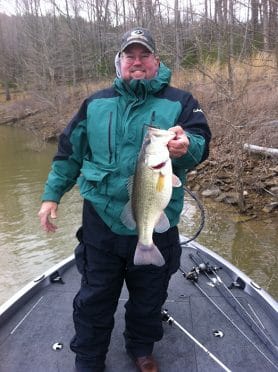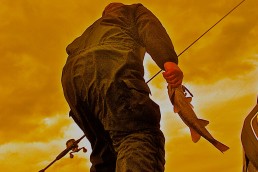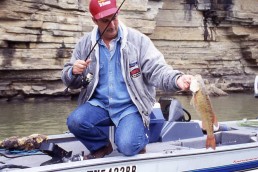Five Awesome Winter Bass Baits
SHARE THIS POST
Bass fishing in the winter can be challenging, but, with the lake to yourself, it’s a great time to enjoy the solitude and silence while possibly catching the biggest bass of the season. Mastering these five coldwater bass baits will help you catch more bass when the water turns cold.
#1 – Jerkbait
The suspending jerkbait is no secret to coldwater bass anglers. It was between the jerkbait and the crankbait for this spot, but, with the lipless crankbait being so versatile, I left the crankbait off the list. In the winter months, most lakes—even those that may be a little dingy in the summer—will clear up. There is little boat traffic and less plankton and other organisms that usually color the water in lakes. For this reason, the suspending jerkbait wins as one of my top winter bass baits. Work this bait along bluff banks where bass will suspend in the winter so they can move from one depth to another with ease. Get the bait down to the depth it’s designed, then start a jerk-jerk-pause retrieve. The pause is usually determined by the water temp, but sometimes you just have to experiment and let the bass tell you what they want. You might have to pause for as long as a minute. Just be patient and you might be surprised.
The bass are targeting dying shad in the winter. The action of these dying shad is dictated usually by the water temp. That action is what you will want to emulate with your presentation. You can’t usually see the action of the dying shad. Thus, you have to try different cadences in your presentation until you get a bite. You can locate the depth of the shad with your electronics so you know how deep they are schooling. Working the jerkbait above the baitfish will attract hungry bass. As the baitfish move away in their defensive ball, your jerkbait emulates a struggling shad that can’t keep up. When this happens, the predators that follow the shad will race to be the first to grab it. This is why, even when bass are sluggish, it might feel like the bass nearly rips the rod out of your hand on the take.
Jerkbaits as topwaters
Another great coldwater option that many anglers may not consider is to fish jerkbaits as a topwater bait. Twitching a floating-style jerkbait, like the Original Floating Rapala, can be deadly on winter bass—especially where the water is clear. Bass will come up from 20 feet in clear water to smash a twitching jerkbait. I learned this technique after getting beat (well, we all did) by our boss with a limit of good-size smallmouth bass. His grin told me exactly how he caught those bass. You see, he had told me all about this technique long before the tournament. I failed to use it and never caught a fish. Neither did my partner.

The boss man was forthright with his tactics before and after the derby. He told me that he knew that all of the young bass anglers lacked the patience and wouldn’t stick with the floater long enough for it to pay off. He was right, and he made a believer out of me. I used it often after that. It not only produces some great bass, but is a fun way to chase them in the winter.
The best jerkbaits for this presentation are the high floaters like the Rapala. This usually means the bait is light, making a spinning rod the optimum choice for this tactic. Light line is important, as well, and is managed much better on spinning gear. A spinning reel with a smooth drag, coupled with a medium-light or even a light action rod works best. The water is often clear where this presentation shines. Your first thoughts might be to use fluorocarbon line. But, the best line for this is monofilament because it floats. You want the bait to ride high on the surface to get the best water disturbance with each subtle twitch. Monofilament does that best.
The best place to use this technique is on bluff walls near a transition zone. Bass love to hang out in areas where different depths are easy to get to and transition zones with a bluff wall give them that option. The bass will move up and down vertically on the wall with changing conditions. They love to move up on transition areas such as points and flats to capture the sun’s rays on those clear winter days. Make sure to be stealthy around the shallow, clear water. Make long casts to keep from spooking the bass you plan to catch.
#2 – Blade bait
The blade bait is a simple bait with features that may not attract anglers in the bait store, but the subtle looks and action of these baits are deadly on coldwater bass. These little baits are very versatile and whether you located bass in deep water and need to jig it like a spoon through suspended fish or found them up shallow where the best presentation is the pump action, the blade bait works great. The pump action is where you slowly raise the blade bait off the bottom, or school of bass. Then, allow it to wiggle back on a slack line. This is done on light line and, with the treble hook on the bait, it does take some practice to keep from hanging up when the bass aren’t suspended. But, it works. Give it a try this winter.
Are you enjoying this post?
You can be among the first to get the latest info on where to go, what to use and how to use it!
#3 – Lipless crankbait
The lipless crankbait is my favorite all-around coldwater bass bait. There are several ways to fish this bait from ripping it through the grass to stroking it on the flats. My personal favorite lipless crankbait is the Rapala Rippin’ Rap. This bait is heavy enough to cast a mile, but subtle enough to work slowly through the water column, generating that slow action as well as sound that triggers reaction strikes so vital to catching more coldwater bass.
These reaction strikes often will result in barely hooking the bass and sometimes hooking it on the outside of its mouth where it just swiped the bait from pure reactionary instincts. Many times, without the right setup, you will rip the hooks free of the bass without ever knowing you had a bite. The best lipless crankbait fishing is a slow retrieve with monofilament and a limber rod. The monofilament will stretch along with the limber rod and this will help increase the hook ratio and, ultimately, the number of bass that make it in the boat.
#4 – Wacky worm
The wacky worm is probably the most underutilized winter presentations taking a backseat to the jig or the jerkbait. The wacky worm is one of those presentations that produce bites under many circumstances and cold water is one of them. The wacky worm doesn’t really look like much in the water. But, bass will react to it when nothing else seems to be working. It’s not just for small fish, either. The wacky worm will catch big bass and it’s a great way to catch the biggest bass in the area when the water is cold. When the bite is tough and the bass are being picky, a free-falling wacky worm can trigger big bites.
Light line and no weight is the trick when the water temps drop. A medium or even a medium-light rod with a spinning reel handles the light line and can detect those subtle winter bites. Just cast your wacky worm out and let it fall. Feed your bait some line so that it falls straight down through the water column, imparting its subtle action until it hits the bottom. The bite will be light and often will go undetected, so watch your line. You will see a twitch or maybe the line just stops before it hits bottom. This is an indication that you have a bite. A slow sweep of the rod is all that’s needed to set the hook with a super-sharp, thin-wire hook.
#5 – Jig
The jig is always a popular choice for coldwater bass. In the summer, I use plastic trailers with lots of action because that’s what the environment demands. In the winter, the mood and action in the water slow to a crawl. Your jig presentation should be a slow drag, inching its way over cover just like a cold crawdad might do.
Your trailer should impart less action, as well, like straight tail worms or fixed pincers on a crawdad trailer. This is what the bass expects when the water is cold. You will get more bites if you stick with the bass’ surroundings by “matching the hatch.”
Working the jig slowly down rocky banks can catch you some big coldwater bass this winter, especially late winter when the days get longer and just a little warmer. Anxious females will pull up early in anticipation for the spring spawn and oftentimes will spawn early as well. This is something that the bass has instinctively developed so that some bass will spawn no matter what happens come springtime. These bass are few and far between. But, once the pattern is established, you can find one or two good bass in those transition zones in spawning areas. Creeks seem to attract bass early. So, check those creeks where the water flowing into the lake can be warmer than the lake, attracting bass early while winter is still holding on.
Beat the cold to boat the bass
It can be a challenge to catch bass in the winter. But, with the right baits and techniques you can catch bass throughout the cold months. Winter bass fishing is a great way to get out of the house and, while it might be cold out there, when you hook into a big bass you tend to forget about it. Winter bass fishing is also a great time to locate some of those secret stumps or boulders that are underwater when spring rolls around and the bass move up to spawn. Give that topwater jerkbait tip a try this winter, but be sure to give it some time. I assure you, after a couple good bites on that floater, you will have the confidence to sling it all day in anticipation for another.
MWO
SHARE THIS POST
Did you enjoy this post?
You can be among the first to get the latest info on where to go, what to use and how to use it!




